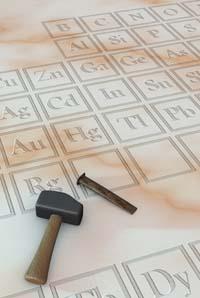Guide to carving the name in the periodic table

If you want to find a new chemical element, you are late. And if you want to make a new item, you'll have to start working fast. Most of the boxes in the Periodic Table are full and there are not many possibilities of creating new boxes.
Before you start, you need to understand that finding, isolating, and identifying an element is not the same. If you want to recognize the discovery of a new element, it is better to do all three things. The oxygen was isolated by the English Joseph Priestly, but he did not realize that that gas was an element, although the French Antoine Lavoissier. Which of the two had merit? In the chemistry history listings the name of Priestly appears, but arguments can also be accepted in favor of Lavoissier. However, if the argument of historical reputation is identification, who should be considered the discoverer of gold or sulfur? These and few other elements appear intact in nature and the human being has always known them.
The idea of the elements was born in ancient Greece. It was a good idea, excellent, but they failed to identify any element from our modern point of view. For them fire, water, air and earth were elements that, of course, do not appear in the periodic table. Water contains oxygen and hydrogen; air contains nitrogen, oxygen, carbon, hydrogen, argon and other elements; the list of elements containing the earth would form a long paragraph; and fire is not energy of interaction between matter, oxygen and other elements, i.e. light and heat.
In favor of the Greeks it must be said that it is difficult to detect elements. And it is even more difficult to isolate these elements. One thing is that a puree perceives if it has carrot and another that leaves a piece of carrot from that puree. To do this, proper technology had to be developed, and the Greeks of old did not strive to study the puree of matter. Others did, with the crucible technology, isolate iron, lead, zinc and antimony. Of course, they had to develop crucible technology.
From there to see a new element XVII. We have to jump into the 20th century, when the German Hennig Brand isolated phosphorus. As Brand was alchemist, his carrot was gold and his puree was a golden body liquid: urine. After collecting and distilling liters of urine, you get a solid white, phosphorus. For him it was a wrong carrot, but it was the first element discovered by man in the modern era.
Chemistry to find chemical elements
Despite being alchemist, Brand's resource was chemistry. In the following years, this resource developed enormously and was greatly benefited by the hunters of the elements. In the following years, the new elements (and not a way of speaking) that came out of the stones and the air. From the minerals were extracted cobalt, nickel, tungsten, etc. ; of gases, oxygen and nitrogen. In addition, they consolidated the basis of chemistry, which is what is explained in the first subjects of those who study chemistry today.
XIX. At the beginning of the 20th century, pure chemistry was given by its best. But they continued to discover new elements thanks to another new technology: electricity. The potential difference of a stack isolated many elements that had not been seen until then. English Humphrey Davy discovered or isolated nine elements using batteries.
Increasingly, the difficulty of finding new elements was in separating similar elements. Therefore, XIX. The second major contribution of the 20th century was spectroscope, a tool for the analysis of light emitted when heating elements. Thanks to this, helium was discovered, among other things, analyzing the sunlight.
Localization and localization of elements. But how long? What elements were missing to discover them? The answer was given by the Russian Dmitri Mendeleiev in 1869, presenting the periodic table. It was not a new technology, but it was necessary to look for the missing elements. The gallium was missing, for example; he announced in Mendeleiev that there was an element under the aluminum and shortly after, in 1875, they found the gallium.
In the end, man has used all the tricks to find elements that appear in nature. The last trick came from the hand of the Curiet. Following radioactivity, they found polonium and radio. Radioactive atoms are unstable and transform over time (before or after) to become stable atoms. Those who are very unstable, have never existed or have disappeared in nature, and in these groups are the new elements that you can find. Therefore, if you want to capture one of them, you will have to create it and be ready, as it will exist at most with a microsecond.
The easiest thing is to catch element 120, which today is the best option. You will need a particle accelerator. And a gas component distribution device and a detector. You will not see your element, but the waste of its transformation. But it doesn't matter. Size your name in the periodic table.
Buletina
Bidali zure helbide elektronikoa eta jaso asteroko buletina zure sarrera-ontzian











